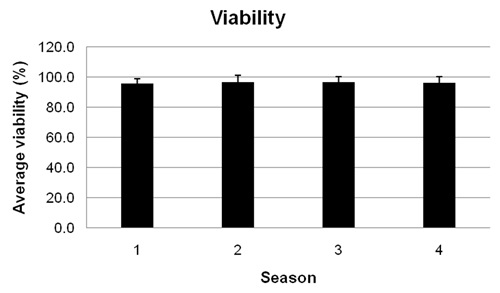Mammalian cell culture is the initial starting point in the procedures used for much of today’s biomedical research and it is important to preserve healthy cells if subsequent experiments are going to be effective.
Recent advances in automated cell counters such as the Luna™ Automated Cell Counter have made it considerably easier to acquire and maintain data related to cell counting. This article shows how these data can be applied to assess and compare seasonal variations in cultured cells.
Experimental Framework
To maintain HS578T cells, Dulbecco's Modified Eagle Medium (DMEM) was used, which comprised 100 µg/ml streptomycin, 100 units/ml penicillin, and 10% heat inactivated fetal bovine serum (FBS). Following trypsinization, the advanced Luna™ Automated Cell Counter from Logos Biosystems and trypan blue staining were used to determine how many cells were viable.
The cell counting data was used to estimate the number of cells, as follows:
Estimated number of cells at passage N = fold increase of cell number x estimated number of cells at passage N-1, where fold increase of cell number = total number of viable cells at passage N or the number of cells seeded at passage N-1 x number of plates seeded.
In order to make seasonal comparison, frozen HS578T cells were thawed and preserved for a specified period of time (season).
Results
Frozen HS578T cells were thawed in October 2012, September 2013, November 2013, and April 2014, with these months representing Seasons 1, 2, 3 and 4, respectively. The cells were then preserved for around 50 days following thawing. The number of viable cells was plotted against days after thawing.
As shown in Figure 1, no significant variation in the cells was observed between 10 and 30 days after thawing, irrespective of the season. However, the cells from season 4 demonstrated a small degree of delayed initial recovery after thawing. Aside from the season 4 cells, growth characteristics of the cells in all other seasons were very similar, both immediately after thawing and up to 40 days later.

Figure 1. Relative growth of HS578T cells in different seasons. For seasonal comparison, the initial cell number was set as 1
Using the Luna™ Automated Cell Counter, different parameters including the size and viability of cells could be obtained. Also, a better understanding regarding the condition of cells could be achieved by comparing these parameters across different seasons. No significant change was seen in the mean size of the cells between the different seasons, as illustrated in Figure 2. The overall mean size of the cells was 20.5 ± 0.7μm. The mean viability of the cells was 96.5 ± 0.5%, with no significant difference observed between seasons, as shown in Figure 3.

Figure 2. Average size of HS578T cells in different seasons. Data were presented as mean ± SD.

Figure 3. Average cell viability of HS578T cells in different seasons. Data were presented as mean ± SD.

Figure 4. Size of cells and viability of HS578T cells over time.
The parameters from Season 1 were further examined over time, as illustrated in Figure 4. The standard size and viability of cells from Season 1 was found to be 20.2 ± 1.1μm and 96.3 ± 4.3%, respectively. No major difference in cell size over time was observed after thawing, apart from after 45 days. The smallest cell size was 17.9μm and the lowest cell viability was 82.1%, measurements that were both obtained 45 days after thawing.
Conclusion
Cell culture forms an essential part of the processes involved in biomedical research and development, but, how we may be able to analyze the basic data obtained using routine cell culturing tecniques has been less appreciated.
Over the years, technical advances have led to the availability of a wide range of automated cell counters. Logos Biosystems’ next-generation cell counters are not only user-friendly but they are cost-effective. As well as enabling the measurement of basic parameters, these systems provide data reports that can be used to compare changes in these parameters over time, therefore potentially enhancing quality control.

About Logos Biosystems, Inc.
Dedicated to the development and commercialization of innovative technologies to support life science research community. Founded at year 2008, Logos Bio is developing a series of lab automation systems and imaging instruments. The primary commercial target of Logos Biosystems is cell biology and molecular biology.
Sponsored Content Policy: News-Medical.net publishes articles and related content that may be derived from sources where we have existing commercial relationships, provided such content adds value to the core editorial ethos of News-Medical.Net which is to educate and inform site visitors interested in medical research, science, medical devices and treatments.